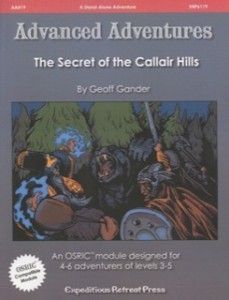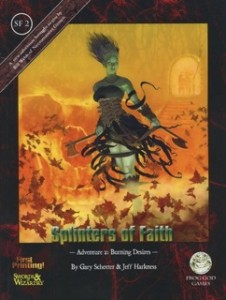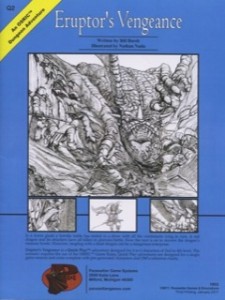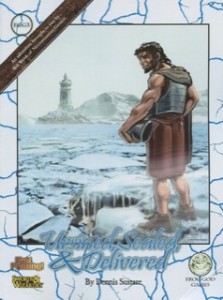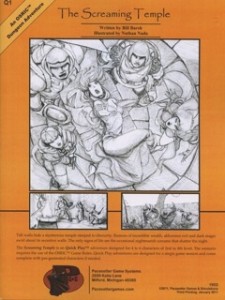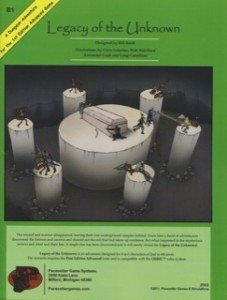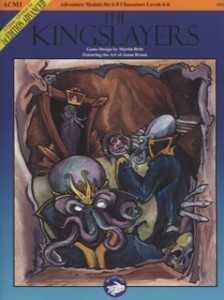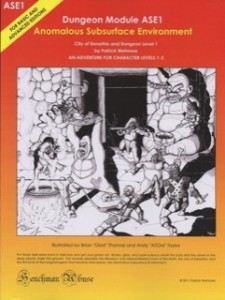
This is one of the best products ever made. Go buy it now.
If you are one of those people who don’t like gonzo or don’t like dungeoncrawls, I urge you to give this one a chance and read on through the review.
I do not say that lightly. I have impossible high standards in most things. Good meals are merely “ok.” The efforts of my staff at work could always be better. While I generally try to be polite in my reviews, it’s certain that the d20 era was not the only one in which great quantities of drivel was produced. “Bryce, what is good?!” This module is good; it hits on every note I’m looking for and more.
Let’s put this puppy in the Bryce context. I stumbled on to some OSR blogs and Lamentations of the Flame Princess a bit before GenCon 2011. My on-again/off-again relationship with D&D (and RPG’s in general) had been in “off-again” mode for several years and was just again perking up. The OSR blogs mentioned dungeoncrawls, and player skill. Dungeons! That’s what I was missing! Puzzles, tricks, traps, new monsters, complex maps! The thrill of something new and unknown! Rules suck! Story game suck! Get your ass in to the dungeon! I stumbled on to Dragonsfoot and read 36 pages of back posts in General. OSR was what I was looking for! Steadings, Barrier Peaks, Tharizdun, and Lost Caverns were my guide, and lead me to Thracia and Towers Dark. Information was difficult to find; ‘best modules” threads are a dime a dozen and most didn’t have much of the 3rd party products on them, and none had the new OSR products. I hungered for more! Enter GenCon 2011. It’s in Indianapolis, where I am. I knew Troll Lord would probably be there and learned of the OSR booth just a few days before the con. It just so happens that I was also feeling a bit … denied. It was one of those “I always buy things for other people and never for myself” kind of Man Moods. So, Never feeling like I buy myself anything, combined with excitement in OSR, and then transported to Game Utopia. Thus I walked away every OSR adventure module that was offered for sale at GenCon. Every adventure at the OSR booth. Every adventure at the Troll Lord booth. A dozen or so from other booths. A mountain of modules and a glorious future in front of me.
Which quickly turned sour. Most were not what I was looking for. Same old same old, or worse. I was thumbing through things like crazy and quickly becoming despondent. There were a few bright spots however for the most part I was confronted with nothing like Steading or Barrier Peaks. OSR was not my savior, just another run of product with some bright spots. I bought the tenfootpole.org domain to categorize my findings in order to help others find Dungeons, with a capitol D, then started writing reviews since there was a near complete absence of information on what the new wave of OSR products held. As an aside, just because it’s not what I’m looking for, a dungeon, doesn’t mean it’s bad, but people need to know what they are getting BEFORE they buy. Anyway, I had a secret. I knew there was a product in that pile that was just as good as ANYTHING ever written by Gary. Paul, or Rob. It was ASE1, the Anomalous Subsurface Environment. It is BADD ASSS! Exactly what I looking for.
Oh ASE1, how do I love thee? Let me count the ways. Let’s start with the artwork. It would be polite to say that ASE1 is spartan in the art category, but what there is is awesome. The cover does a pretty good job of setting the scene. A giant idol with a hon on it’s head with multiple hearts impaled on it while a group of adventurers battle an excellent rendition of Morlocks and their ape servant, while a giant cookpot looms. It recalls memories of the 1E PHB and DMG but it not a knock-off like the Hackmaster version or even a style similarity like the DCC line.. It tells you what’s inside and pretty perfectly sets the mood for what’s to come. I’d like to mention two others. The first is a group of adventurers drooling over a dancing girl, which again recalls the humor found in the 1e DMG illustrations. Finally there is a section of hallway illustrated, a corner, with great devil faces carved in to two walls and bones strewn on the floor with a doorway in the background. Again, this speaks to me and does a great job of evoking the DUNGEONCRAWL mood. Finally, a decent number of monsters get some illustrations also, included the dreaded Sasquatron! Picture a bigfoot who’s right arm has been replaced with a giant crab claw and who’s head is a glass dome with machinery inside. Nice!
Way the Second that I love thee: it’s not just a dungeoncrawl, it’s a way of life! Which is to say, it’s also a setting book! About half the book details the campaign world, the region the module is set in, and the City of Denethix, the major population setting nearby. Context! We get context! Woo Hoo! And what a context! gonzo. Gonzo! !GONZO! Our setting is the far future of a ruined earth, where dinosaurs, wizards, and super-science go hand in hand. The Gods are AI satellites who circle overhead and make themselves know on the viewtrons in the temples. And what gods they are! The God of cutlery. The god of dinosaurs. The God of 12 annihilations. The god of torturer. Get your freak on Mr DM and pick something wacky or obscure to manifest on viewtron as a god! The region itself, The Land of One Thousand Towers, is nicely described also. Countless mad wizards all have their own small kingdoms which they use as their own research playground. The inhabitants are all slaves & chattel, serving the whims of their mad wizard masters.THIS. This is something a DM can work with. Finally we come to the region of the City of Denethix, it’s surrounding villages and the city proper. Again, marvelous ideas are detailed. In the village of Lugosi, all of the exterior buildings surfaces are covered with mirrors. The villagers have forgotten why, but assume it is something vampire related. And that’s just one tidbit from one of the 14 villages described. The writing is terse, dense, and FULL of adventure seeds. Mysteries Abound! The City of Denethix is ruled by an even madder than most wizard, with a secret. The impact is that the city if relatively free and contains less atrocities per square block than any of the other lands, by far. We get information on the League of Flesh Debtholders, the Street of Lesser Men, the Palais Immaculate, the Street of Tormented Flesh, and many many others. All with just enough description in 3 or 4 sentences to fire the imagination but not so much as to bore you to death. EXACTLY the kind of writing I’m looking for!
THE THIRD RESON. Tables! Did I mention the tables?!?! We get a boatload of tables with which to gonzo up our game. Not just a table for rumors, or for ‘What do I find in the curio shop’ (Doll made of human teeth, wired together. or The Societies been kidnapping slavers. Been Leaving their brains behind, Gross, eh?) but also for random shops, interesting events, danger, city & village encounters, Fashion Styles of Wealthy Gentlemen and Haute Couture for Ladies, Hirelings for hire and perhaps my favorite “I have a horrible secret.” All of these, and more, are loaded down with both interesting and gonzo encounters and just enough detail in a sentence to get the DM off and running.
Ok, look, there is enough detail in the first half of this book to run the most awesome campaign you’ve ever had. And that’s without the actual dungeon! Never setting foot in there you can have adventure after adventure with the details provided in the first half. I didn’t even cover the brief but interesting changes to the backstories of the demi-humans, or goblin hive-minds, or some of the wizards which are detailed, or any even most of the first half of the book. Your take-away here is that you get a campaign world, region, and city/environs which is rich in imagination and lots of evocative information for adventure seeds and local color. All of it in a scant 40 or so pages of easy to read text delivered in a clear and simple dense style. It’s like 41 pages of the best one and two liner room descriptions that Gygax and Kuntz every did. And THAT is no small compliment.
Ok ok ok, time for the dungeon portion. The Anomalous Subsurface Environment. We get a backstory. before the fall of man scientists find an underground area with strange ore and stranger creatures. They explore and start to conquer the levels, creating labs and so on as they go. Things go bad and the place is sealed up tight, then mankind falls and the place is forgotten about. Fast forward to our mad mad mad future and a the players are given a hook of a new place, as a entrance is just uncovered. We get about 30 pages of dungeon covering about 130 keyed encounters n two locations: the gatehouse to the dungeon and the first level of the dungeon. The gatehouse is meant to be a monitoring center for the sealed dungeon below. The gatehouse has a pretty good ‘looping’ map, with multiple way to get form point A to point B. The first level has an EXCELLENT map! Lots of interesting areas detail on the map and lots of ways to get form point A to B. It’s really one of the best maps I’ve seen so far, rivaling Mordenkainen’s Fntastic in the alternate paths and interesting rooms area.
We get 34 new monsters in the last 10 or so pages of the module. Creature like the bigfoot hybrid I mentioned above. Corpse-jelly, dober-men, blade zombies, grunkies, jawheads, and dozens of other strange and new beasts. Nothing scares the shit out of a player more then encountering a new monster. Whats it’s immune to? What are it’s weaknesses? I LOVE new monsters in modules. I want my players to feel like they are exploring the unknown and facing unknown beasties is a great way to communicate that feeling.
Tricks & Traps! Traps with warnings and tricks that fit in. Come one, push the big red button! You know you want to! There’s probably a +1d6 STR button in there somewhere. Do it! Do it! I LOVE giving a PC enough rope to hang themselves with. You know someone is going to press the button./eat the tree fruit, drink from the basins, etc. Again, this gets back to the Unknown and it’s place in a dungeon module. The feeling of mystery, unjustified, is what leads to the delight in wonder of a good dungeoncrawl.
I mentioned the factions, right? The dungeon has factions! Factions are great! it allows the PC’s to interact with the inhabitants in much more than just a hack n slash way. The inhabitants come alive and have real goals and motivations. They’re not just cookie-cutter kobolds waiting to be cut down by the party.
Just writing about this thing has my blood racing again. It’s an absolutely amazing setting and a wonderful dungeoncrawl. It hits all of the points I’m looking for: evocative & terse descriptions, imaginative settings, tricks & traps, new monsters, great multi-path maps, “naturalism”, factions, vermin. I could go on and on.
If this module had multiple dungeon levels, instead of just two, I would CLEARLY place it as the best module of all time, beating out Steading, Barrier, Mordenkainen, Dark Tower and even Thracia. I can only hope that the author produces more dungeon levels to what is surely a megadungeon to rival Greyhawk castle. If the author is reading this, please contact me: I would like to have millions & millions of your babies, the hope that your stunning creativity will rub off on me.
GO BUY THIS NOW.

